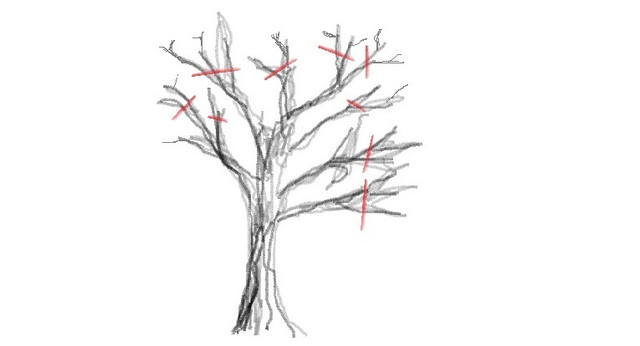Do you have unwieldy fruit trees plaguing your yard? We’ll explain how to prune fruit trees for maximum growth and give some tips on the best time to do it.
Fruit trees need pruning annually to stop them from becoming overgrown and to improve productivity and overall health. Pruning can help to reduce invasion from pests and disease and makes the canopy stronger, this enables the tree to produce larger and better quality fruit for many years. Pruning works for all types of fruit trees, including stone fruits (cherries, apricots, peaches), bushes (raspberries, blueberries) and pome fruits (pears, apples).
There are two types of pruning:
- Summer pruning: This lets sunlight ripen fruit and ensures a good shape for the following year, this works best for trees with restricted forms like pyramids (see below).
- Winter pruning: This method is for all other forms of fruit trees and bushes, pruning should be done at the bud break stage (when new shoots and leaves start to grow).
We’ll show you how to prune fruit trees in 3 simple steps.
How to Prune Different Types of Fruit Tree

Depending on the type of fruit tree, it will need to be pruned into a certain shape for optimal growth.
- Pyramid: This shape has the central leader trunk, from which the other scaffolding branches grow. It is wide at the base and narrow at the top, making it sturdy and productive — however, it can grow tall which may make it difficult to manage. The pyramid form works best for pear, apple, persimmon and pecan trees.
- Modified pyramid: Lateral branches remain and the top of the central leader trunk is removed. It has a strong trunk and branches and is easy to harvest. This shape works for cherry, apple, walnut, apricot, plum, nectarine, pecan, pear and peach trees.
- Open center: This form doesn’t have a central leader trunk like the others, meaning more sunlight enters, but the branches may be weaker and there will be more shade from the leaves of the upper branches. This shape is great for apricot, olive, peach, pear, and plum trees.
Check out our guides for more specific information on how to prune apple trees and when to prune apple trees.
Tools Needed for Pruning Fruit Trees



Having the right tools goes a long way toward proper pruning. You’ll need to have good-quality tools that are sharp and properly cleaned between uses. Here are a few ideas of what to keep on hand:
- Loppers: These are long-handled pruning shears that are designed to cut twigs and branches 1-3 inches in diameter.
- Secateurs: Smaller than loppers, these are used to nip anything less than ¾-inch in diameter.
- Pruning saw: This is a thin hand saw that can be used for sawing large branches. The blade size makes it ideal for working in the restricted space of the fruit tree.
- Ladder: This may be needed to reach the top branches of the tree.
Let’s look in further detail at how to prune fruit trees.
1. Remove Dead Wood



The first step when pruning fruit trees is to prune any dead or diseased wood. To identify dead wood, look for branches that are brittle and break easily, diseased wood will be a different color. Grab your secateurs and loppers and chop off any smaller branches – cut back to the nearest bud where the wood is still healthy.
Next, remove any new shoots (or suckers) from the base of the trunk using the secateurs — these will use up energy from the tree which can be used to grow fruiting wood. You’ll also want to prune any perfectly vertical branches, these are called water sprouts.
2. Thinning



Thinning opens up the canopy which increases fruit production and can reduce the risk of disease and pests.
- Using the loppers or saw, prune the branches that grow downwards as they won’t be able to hold any fruit.
- Prune any upward-growing branches, as they may damage others, and prune any whorls. Whorls are places where more than three small branches grow from the same place.
- Prune any inward-growing branches that may rub against others, aim for evenly-spaced branches.
3. How to Prune Fruit Trees: Prune Back



The final step is one last “haircut”. Prune the outermost growth, so the branches become thicker and shorter when they grow and are strong enough to hold fruit. Thin out fruiting buds so that they are four to six inches apart, as this will help ensure that the fruit tastes sweet enough.
When this final step is finished, remove all the pruned wood from the area. Pruned branches can be used as trellises or plant support when growing climbing vegetables, to make natural fencing or habitat mounds to attract invertebrates to your yard. They can also be used to make wood chips which can be spread on flower beds, or recycled locally.
Read more:
- The 5 Best Free Tree Identification Apps
- Easy Lemon Tree Fertilizer for Healthy Growth
- 10 Facts About Trees: How They Feel & Communicate
Do you like this post?








